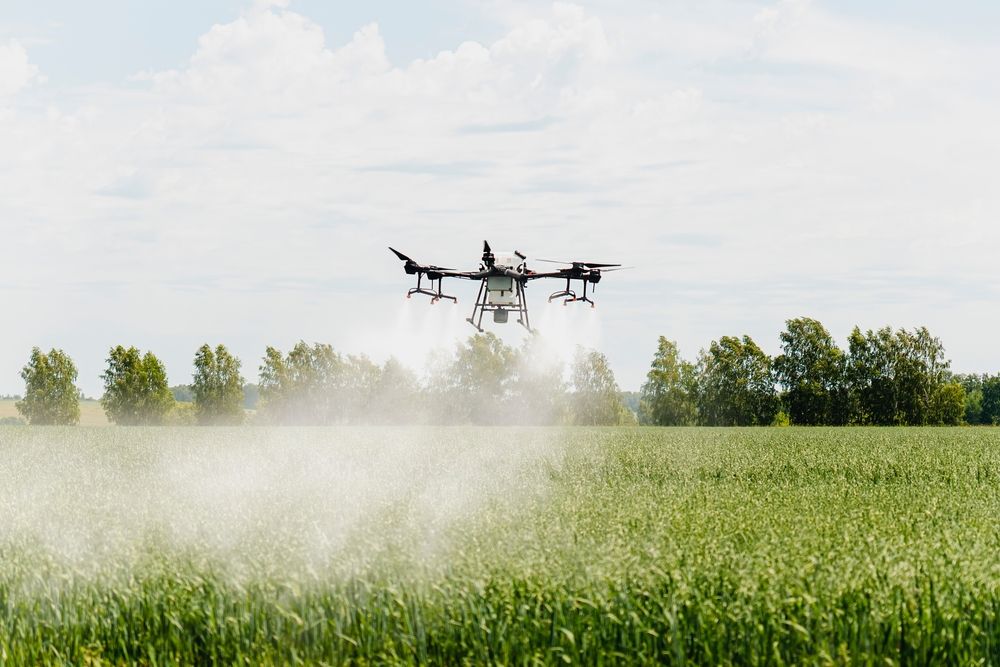The Top 5 Tech Trends In Horticulture
)
Horticulture, the age-old practice of cultivating plants, has always been a blend of art, science, and hard work. But today, as the world faces increasing demands for food, labour shortages, and environmental challenges, the industry is embracing a wave of technological advancements. Robotics, artificial intelligence, drones, and vertical farming are leading the way, reshaping how plants are grown, managed, and distributed. Let’s dive into the top tech trends that are driving this transformation and explore what they mean for the future of horticulture.
Robotics
Robots are making a big impact in the horticulture world, especially in nurseries where the need for efficiency and precision is greater than ever. By automating tasks that were once manual and time-consuming, robotics is helping nurseries streamline operations and improve the working environment for their staff.
Transplanters and Automated Potting Systems
Transplanting seedlings by hand can be a painstaking and repetitive task. Enter transplanters—automated machines that handle this delicate job with speed and precision. These machines take seedlings from trays and place them into pots, a process that traditionally required a team of workers. Now, automation completes this task faster and more consistently, reducing labour costs and increasing output.
Conveyor Belts and Plant Handling RobotsConveyor belts and plant handling robots further enhance nursery efficiency by moving plants around the facility without the need for manual labor. These systems transport plants from one stage of production to the next—whether it’s potting, watering, or packaging—minimising plant damage and speeding up operations. Plus, they help improve working conditions by taking over tasks that are physically demanding for human workers.
Improving Ergonomics and Worker SafetyBy automating heavy lifting, repetitive movements, and other strenuous tasks, robots are not only boosting productivity but also making nurseries safer places to work. This technology reduces the physical strain on workers, which leads to fewer injuries and a more sustainable work environment.

Advanced Inventory Management
Keeping track of inventory is a critical part of running a successful horticulture business. Whether it’s a nursery or a greenhouse, managing thousands of plants at different stages of growth can be challenging. Fortunately, advanced inventory management systems are here to help.
Real-Time Monitoring and Data Analytics
Today’s inventory management systems are equipped with sensors, RFID tags, and IoT (Internet of Things) technology, allowing growers to monitor their inventory in real time. These systems track everything from the location and health of each plant to its growth stage. With this data at their fingertips, growers can make informed decisions about watering, fertilisation, and harvesting, ultimately optimising resource use and reducing waste.
Automated Inventory Tracking and Replenishment
Automation is key to effective inventory management. Automated systems can monitor stock levels and trigger orders for new supplies when needed, ensuring that nurseries never run out of essential items like seeds, fertilisers, or pots. This not only keeps operations running smoothly but also prevents overproduction, which can lead to waste.
Seamless Integration with Other Business Systems
The best inventory management systems can integrate with other business software, such as accounting, sales, and customer relationship management (CRM) tools. This integration gives horticulture businesses a holistic view of their operations, from production to sales. For instance, by analysing sales trends alongside inventory levels, growers can better predict demand and adjust production accordingly.
Generative AI: Smarter Decisions Through Data
Artificial intelligence (AI) is revolutionising many industries, and horticulture is no exception. Generative AI, a branch of AI that learns patterns from data, is particularly powerful in helping growers make smarter decisions and improve crop yields.
Predictive Analytics for Crop Management
Generative AI can analyse historical data to predict future outcomes, such as the optimal times to plant, water, or harvest crops. By identifying patterns in past data, AI can provide insights that might not be obvious to human growers. For example, it can forecast how changing weather conditions or soil quality will affect crop growth, allowing growers to adjust their practices and maximise yields.
Precision Agriculture and Tailored Care
AI-driven systems are also enabling precision agriculture, where each plant receives care tailored to its specific needs. Generative AI can analyse data from soil sensors to determine the exact amount of water or nutrients a plant requires. This ensures that plants are getting the right care at the right time, leading to healthier crops and higher yields. Additionally, AI can spot early signs of disease or pests, enabling quick and targeted responses.
Supporting Sustainability
Generative AI is a powerful tool for promoting sustainability in horticulture. By optimising the use of resources like water, energy, and fertilisers, AI can help reduce waste and lower the environmental impact of growing operations. This makes it easier for growers to adopt sustainable practices while also keeping costs down.

Drones: Aerial Insights for Pest and Disease Management
Drones are quickly becoming a must-have tool in horticulture, particularly when it comes to managing pests and diseases. With their advanced sensors and imaging capabilities, drones can monitor crops from above, providing real-time data that helps growers address issues before they escalate.
Early Detection of Pests and Diseases
One of the biggest advantages of using drones is their ability to detect pests and diseases early on. Equipped with multispectral and thermal cameras, drones can capture detailed images of crops, revealing changes in plant health that might indicate a problem. For example, drones can detect subtle shifts in leaf colour or temperature, which are often early signs of disease or infestation. By catching these issues early, growers can intervene sooner and reduce the need for widespread pesticide use.
Precision Treatment and Reduced Chemical Use
Drones make it possible to apply treatments with pinpoint accuracy. Drones can target only the affected areas, applying just the right amount of pesticide or fungicide where it’s needed most, instead of spraying entire fields. This targeted approach not only reduces the amount of chemicals used but also minimises the impact on the environment, preserving beneficial insects and other organisms.
Monitoring and Mapping Over Time
Drones are also invaluable for monitoring crop health throughout the growing season. By regularly capturing images of crops, drones can create detailed maps that show how plant health is changing over time. These maps help growers identify problem areas and make adjustments to their management practices, leading to healthier crops and higher yields.
Vertical Farming and Hydroponics
As cities expand and available farmland shrinks, vertical farming is emerging as a sustainable solution for growing food in urban areas. By stacking crops in layers and using advanced growing techniques like hydroponics, vertical farming offers a way to produce food efficiently, even in limited spaces.
Maximising Space and Yield
Vertical farming excels at making the most of limited space. By growing crops in vertically stacked layers, these farms can produce much more food per square foot than traditional farms. This is especially valuable in urban areas where land is scarce and expensive. Moreover, vertical farms operate year-round, with controlled environments that can be adjusted to meet the specific needs of each crop, regardless of the weather outside.
Water and Resource Efficiency
Hydroponics, a key technique in vertical farming, is incredibly efficient when it comes to water use. Unlike traditional farming, which can lose significant amounts of water to evaporation or runoff, hydroponic systems recycle water, using up to 90% less water than conventional methods. This makes hydroponics an attractive option in areas where water is limited or costly.
Reducing the Carbon Footprint
Vertical farming also offers a way to reduce the carbon footprint of food production. By growing food closer to where it’s consumed, vertical farms can cut down on transportation and the emissions that come with it. Additionally, the controlled environments of vertical farms allow for more efficient use of energy, as lighting, temperature, and humidity are all optimised for plant growth. Some vertical farms even tap into renewable energy sources like solar or wind power, further shrinking their environmental impact.
The integration of robotics, advanced inventory management, generative AI, drones, and vertical farming into horticulture is reshaping the industry in exciting ways. These technologies are driving improvements in efficiency and productivity, while also supporting more sustainable and resilient growing practices.
As the horticulture industry continues to evolve, embracing these technological advancements will be key to meeting the world’s growing demand for food, reducing environmental impact, and ensuring the long-term sustainability of agriculture. What was once a field rooted in tradition is now at the forefront of innovation, and the future looks brighter than ever.
By staying ahead of these trends, growers can not only improve their operations but also contribute to a more sustainable and prosperous world.
At Glee, we're inviting industry experts to contribute to our blog! We believe that your unique perspectives can educate and inspire our audience while enhancing your presence in the community.
We're looking for:
- Well-crafted articles,
- Practical guides,
- Insights and case studies
and more...
Take the opportunity to make an impact in the industry and submit your guest post! We’re excited to hear your ideas.
